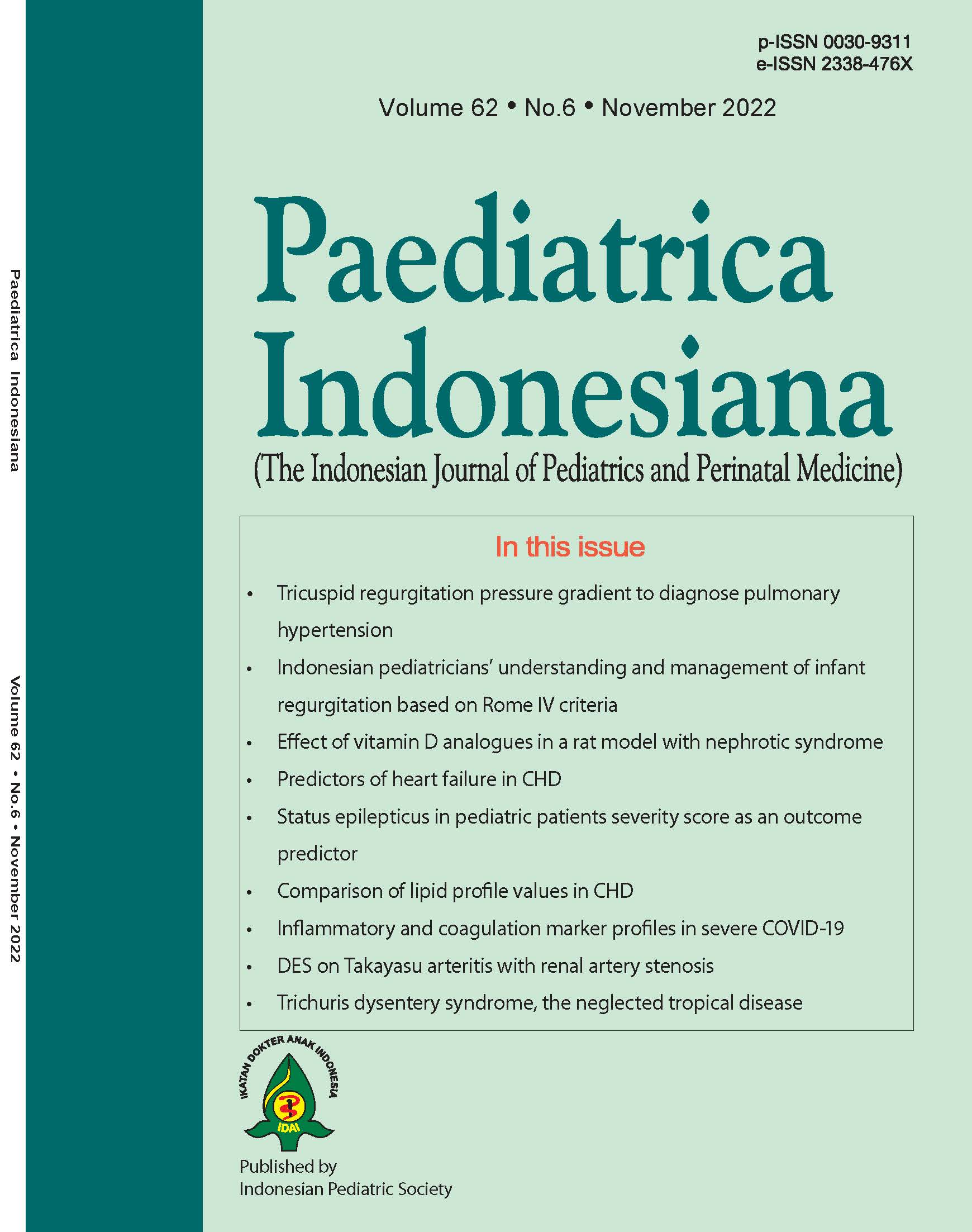Status epilepticus in pediatric patients severity score (STEPPS) as an outcome predictor in children
Abstract
Background Status epilepticus (SE) is a neurological emergency, with short-term mortality ranging from 0.9 to 3.6% in children. The disease burden of SE includes morbidity, treatment costs, and mortality. Various scoring tools for predicting outcomes in adult SE cases have been widely studied, but there are few tools for predicting outcomes in children with SE.
Objective To evaluate the usefulness of status epilepticus in pediatric patients severity score (STEPSS), a clinical score for predicting functional outcome and mortality in pediatric patients with status epilepticus, as well as to identify characteristics of SE patients.
Methods This retrospective cohort study included 88 pediatric patients with status epilepticus aged >1 month to ?18 years by consecutive sampling, who were treated at Dr. Sardjito Hospital, Yogyakarta. All subjects underwent assessment by STEPPS score, which were compared to functional outcome assessed by Pediatric Overall Performance Capacity (POPC) score and mortality.
Results STEPPS > 3 was significantly correlated with poor functional outcome (OR 2.85; 95%CI 1.04 to 7.87; P=0.043), but was not significantly correlated with mortality outcome in children with SE (P=0.411).
Conclusion STEPPS score with cut-off >3 can be used as a predictor of poor functional outcome in pediatric patients with SE aged >1 month to ?18 years, but cannot be used as a predictor of mortality.
References
2. Chin RF, Neville BG, Peckham C, Bedford H, Wade A, Scott RC. Incidence, cause, and short-term outcome of convulsive status epilepticus in childhood: prospective population-based study. Lancet. 2006;368:222–9. DOI: https://doi.org/10.1016/S0140-6736(06)69043-0
3. Sidharth, Sharma S, Jain P, Mathur SB, Malhotra RK, Kumar V. Status Epilepticus in Pediatric patients Severity Score (STEPSS): a clinical score to predict the outcome of status epilepticus in children- a prospective cohort study. Seizure. 2019;71:328–32. DOI: https://doi.org/10.1016/j.seizure.2019.09.005
4. Rossetti AO, Logroscino G, Milligan TA, Michaelides C, Ruffieux C, Bromfield EB. Status Epilepticus Severity Score (STESS): a tool to orient early treatment strategy. J Neurol. 2008;255:1561–6. DOI: https://doi.org/10.1007/s00415-008-0989-1
5. Goyal MK, Chakravarthi S, Modi M, Bhalla A, Lal V. Status epilepticus severity score (STESS): a useful tool to predict outcome of status epilepticus. Clin Neurol Neurosurg. 2015;139:96–9. DOI: https://doi.org/10.1016/j.clineuro.2015.09.010
6. Torres-Espíndola LM, Demetrio-Ríos J, Carmona-Aparicio L, Galván-Díaz C, Pérez-García M, Chávez-Pacheco JL, et al. Comorbidity index as a predictor of mortality in pediatric patients with solid tumors. Front Pediatr. 2019;7:48. DOI: https://doi.org/10.3389/fped.2019.00048. eCollection 2019.
7. Kang DC, Lee YM, Lee JS, Kim HD, Coe CJ. Prognostic factors of status epilepticus in children. Yonsei Med J. 2005;46:27–33. DOI: https://doi.org/10.3349/ymj.2005.46.1.27
8. Ferro MA, Chin RFM, Camfield CS, Wiebe S, Levin SD, Speechley KN. Convulsive status epilepticus and health-related quality of life in children with epilepsy. Neurology. 2014;83:752-7. DOI: https://doi.org/10.1212/WNL.0000000000000710
9. Martinos MM, Pujar S, Gillberg C, Cortina-Borja M, Neville BGR, de Haan M, et al. Long-term behavioural outcomes after paediatric convulsive status epilepticus?: a population-based cohort study. Dev Med Child Neurol. 2018;60:409-16. DOI: https://doi.org/10.1111/dmcn.13636.
10. Koubeissi M, AlshekleeA. In-hospital mortality of generalized convulsive status epilepticus: a large US sample. Neurology. 2007;69:886-93. DOI: https://doi.org/10.1212/01.wnl.0000269791.96189.70.
11. Gurcharran K, Grinspan ZM. The burden of pediatric status epilepticus: epidemiology, morbidity, mortality, and costs. Seizure. 2019;68:3–8. DOI: https://doi.org/10.1016/j.seizure.2018.08.021
12. Leitinger M, Kalss G, Rohracher A, Pilz G, Novak H, Höfler J, et al. Predicting outcome of status epilepticus. Epilepsy Behav. 2015;49:126–30. DOI: https://doi.org/10.1016/j.yebeh.2015.04.006
13. IDAI. Rekomendasi penatalaksanaan status epileptikus. Jakarta; Badan Penerbit IDAI: 2016. p.1-3
14. Larasati, S., Nuridian Y. Konsep Neuroplastisity, Neurobehaviour, Neuroscience dalam kehidupan. Fak Kedokteran, Univ Jember. 2019; DOI: https://doi.org/10.13140/RG.2.2.36699.92967
15. Cherian A, Thomas SV. Status epilepticus. Ann Indian Acad Neurol. 2009;12:140-53. DOI: https://doi.org/10.4103/0972-2327.56312.
16. Martinos MM, Yoong M, Patil S, Chong WK, Mardari R, Chin RFM, et al. Early developmental outcomes in children following convulsive status epilepticus: a longitudinal study. Epilepsia. 2013;54:1012–9. DOI: https://doi.org/10.1111/epi.12136.
17. Sutter R, Marsch S, Fuhr P, Ruegg S. Mortality and recovery from refractory status epilepticus in the intensive care unit: a 7-year observational study. Epilepsia. 2013;54:502–11. DOI: https://doi.org/10.1111/epi.12064.
18. Ganguly K, Poo M. Activity-dependent neural plasticity from brench to bedside. Neuron. 2013;80:729-41. DOI: https://doi.org/10.1016/j.neuron.213.10.028.
19. Scharfman HE. Epilepsy as an example of neural plasticity. Neuroscientist. 2002;8:154–73. DOI: https://doi.org/101.1177/107385840200800211.
Copyright (c) 2022 Niken - Iswarajati, Intan Fatah Kumara, Agung Triono

This work is licensed under a Creative Commons Attribution-NonCommercial-ShareAlike 4.0 International License.
Authors who publish with this journal agree to the following terms:
Authors retain copyright and grant the journal right of first publication with the work simultaneously licensed under a Creative Commons Attribution License that allows others to share the work with an acknowledgement of the work's authorship and initial publication in this journal.
Authors are able to enter into separate, additional contractual arrangements for the non-exclusive distribution of the journal's published version of the work (e.g., post it to an institutional repository or publish it in a book), with an acknowledgement of its initial publication in this journal.
Accepted 2022-12-05
Published 2022-12-05













